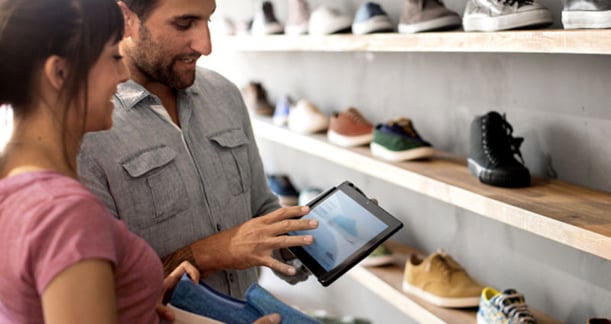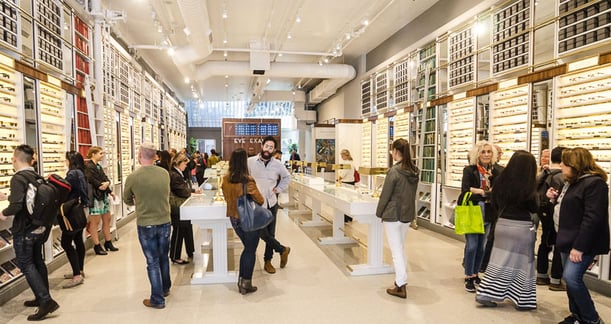Kim Lear believes Millennial and Gen Z shoppers want two seemingly incongruous things – a seamless high-tech experience combined with the personal attention offered in a couturier’s salon. Cookie cutter chain stores and megamalls are out. Showrooms and the retail experience of shopping in smaller stores with boutique personalities are in.
The Millennial researcher, author and speaker – among the featured speakers at RetailSpaces '17 – is currently collaborating on a book titled “Gen Z @ Work: How the Next Generation Is Transforming the Workplace” with author David Stillman.
Recently she shared a few thoughts on the process of designing brick and mortar stores for younger generations and how different age groups can work together to design optimal retail experiences.

Elevating the In-Store Experience
While the current landscape is littered with decimated big-box stores, a few brands are surviving and even thriving in this environment, fighting online retailers through training, knowledge, smart use of tech and personal attention, Lear says. To cut costs, some larger chains are trimming staff, minimizing training—and failing epically.
“We’re just emerging from a place where any 16-year-old could get a job at any of these places. However, the importance of the sales person has become elevated because people still have a lot of questions...but less patience,” she says.
Nordstrom, however, is playing it smart. “For the in-person shopping experience, a few brands are excelling. Nordstrom stands out in the department store category. They’re incorporating the right tech into their business model and they have an effective interactive element and opportunities for people to do price comparisons (in store).”
A piece in Forbes delineates Lear’s points. Nordstrom hires bright, proactive employees and empowers them to make decisions to keep their customers happy. They’re also taking a smart approach to tech—nothing showy, but adaptations that truly enhance the shopping experience. They allow customers to use mobile technology to pay anywhere in the store without waiting in line.
Another Nordstrom tech offering – a “3D foot-scanning technology” to allow customers to match their feet to shoes without having to try on every pair available.

Bring in the Big Guns
Lear's first job fresh out of college at Sak's taught her firsthand the significance of training and nurturing a sales team. It was the height of the post-2008 recession--and luxury items were the last thing on most shopper's list.
“Selling luxury goods at that time wasn’t easy. They needed people to sell the shit out of luxury goods. They would bring in ambassadors from the designer who would take us out for a nice meal and share their inspiration for this line,” Lear recalls.
“To have people come in and discuss the muses for their resort wear collection. All of these things made people passionate about what they were selling.”
Today the Minneapolis-based consultant is working with numerous retail clients to help them adapt to Millennial (and in just a few years) Gen Z shoppers.
“A few of the things they’re doing include creating smaller, highly curated versions of their stores and building them in urban areas closer to where Millennials live,” she says.
“Young people don’t want to drive 40 minutes to pick up laundry detergent.”
“Big Box retailers have started showing up where young people are—densely populated urban areas.” As a counterbalance, they’re emphasizing smaller, less-crowded spaces (a respite from the urban rush) and providing smaller sizes for millennial shoppers who are staying single longer.
Warby Parker—Seven Years to Superstardom
Warby Parker (founded in 2010) has become the go-to name when singling out the innovative, next-generation retail superstars. From an online sensation, the prescription eyeglasses and sunglasses brand has made a seamless transition to brick & mortar, with 40+ locations nationwide and growing.
“Their experience is so consumer driven. They give people a reason to have a human relationship with the brand,” says Lear. Again:
''Investment in training makes the difference.”
A big part of Warby Parker’s success is the time and money the eyewear retailer puts into training its staff to interface with customers, Lear says. Warby Parker also wins points for the seamless ways in which it uses technology to make “the shopping experience as convenient as possible for the customer.”
She adds, “Warby Parker puts a lot of money and time into training people to interface with customers,” even to the point of adapting their “pace” to that of each customer—from in-a-rush to slow and methodical.
Again, Lear emphasizes the importance of Warby Parker’s thoughtful tech approach. “Some stores now are trying the ‘look at us; we’re so cool’ approach to tech, but young people are saying ‘no’ to this.’”

Online Stores in 3D
A key point for contemplation—while older generations grew accustomed to seeing their favorite retailers develop an online presence, Gen Z has grown up knowing brands like Warby Parker and Birchbox (NY-based makeup retailer) through their websites, with brick and mortar coming later.
Millennials are drawn to the “showroom mentality” embraced by stores like West Elm, which has stripped down the once overcrowded look of its sales floor and MM.Lafleur, an online retailer for business women which has showrooms in New York and DC.
Embracing an old-school approach, MM.Lafleur creates a personalized shopping experience by requiring shoppers to make appointments and supply them with their sizes and looks they prefer in advance.
Millennial Work Styles
We’ve spent a lot of space discussing the challenges (and successes) of tailoring brick and mortar shopping to the Millennial/Gen Z mind and wallet (sorry, payment app).
But what role are younger generations playing in creating the stores targeting their generation?
Lear points out a few traits. “I think that young people – including Millennial and Gen Z – are very dependent on one another and they’re hungry to influence each other. There is an element of group-think that happens in the marketplace today and, for brands that can be a great thing because… "The'll do the marketing for you."
The Boomer Perspective
Its not just lip service, older generations have a lot to offer during retail store planning, and design stages because they remember the personal shopping experience prominent before megamalls and the Wal-Mart revolution—something younger shoppers have fallen in love with thanks to the personalized experience offered by many boutique online vendors.
Simply put, boomers remember going to standalone stores to have a suit tailored or dress fitted by someone they knew by name – Millennials crave this experience.
“I think having an integrated team working on the design of stores is critical,” Lear says. “There is a swing back to a community driven personalized shopping experience. For boomers who grew up ‘pre-mall,’ they could have an interesting insight into that experience…that traditional, localized, community driven approach to retail.”
When Gen Z Hits the Workplace
Collaboration has its strengths, but she believes there will be a shift from immersive collaboration to greater independence.
“Lots of workplaces have looked at their culture and the type of work they do and asked if this is the best way for us to work,” she says. “In this case, the answer is ‘no.’ It just leads to more distraction.”
An interesting dichotomy—when Generation Z enters the workforce, their lifetime of tech use will make them more self-determining employees (less dependent on brainstorming and whiteboards). They’ll work alone, she believes, but when it comes to how they’ll shop, conformity will rear its head.
“In the marketplace, this generation (Z) will follow the pack.”

One More Thing
Though we talk about Millennials, Gen Z, Boomers, etc., Lear emphasizes that tech has impacted ALL generations—the expectation of a seamless retail process is spanning all age groups.
We’ve all lost patience for waiting in lines and Amazon has trained us to expect overnight or even same-day delivery. “The most important thing is convenience, otherwise, if someone is going to make a purchase, they’ll make it online.”
Lear adds, “Until recently you would go into a Best Buy, place an order and sometimes have to wait a week for your purchase to arrive. At this point, even a 60-year-old is not cool with that anymore because they know what’s possible.”

Posted by
Physical Retail Reimagined.
RetailSpaces is a community for store development and design innovators.
March 29-31, 2026 | San Antonio, TX
Learn More!








Comments